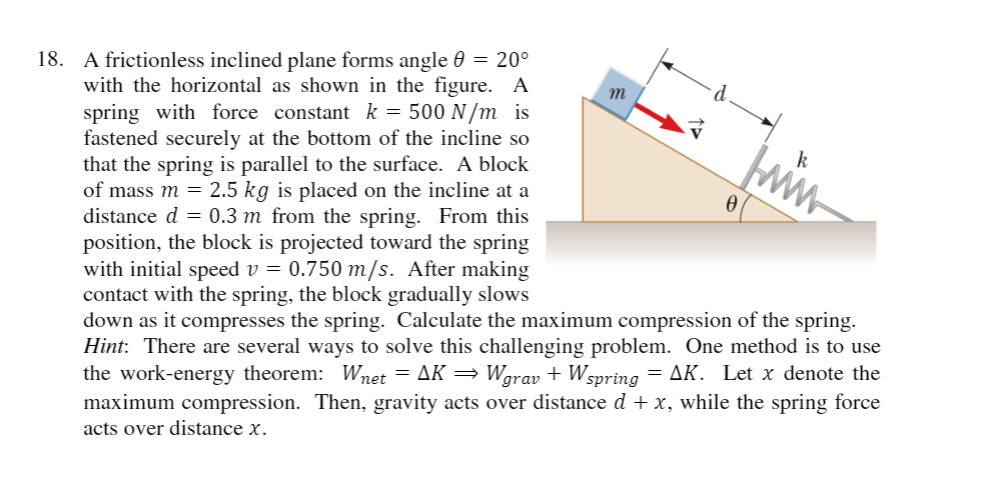18. A frictionless inclined plane forms angle 0 = 20° with the horizontal as shown in the figure. A spring with force constant k = 500 N/m is fastened securely at the bottom of the incline so that the spring is parallel to the surface. A block of mass m = 2.5 kg is placed on the incline at a distance d = 0.3 m from the spring. From this position, the block is projected toward the spring with initial speed v = 0.750 m/s. After making contact with the spring, the block gradually slows down as it compresses the spring. Calculate the maximum compression of the spring. ww.
18. A frictionless inclined plane forms angle 0 = 20° with the horizontal as shown in the figure. A spring with force constant k = 500 N/m is fastened securely at the bottom of the incline so that the spring is parallel to the surface. A block of mass m = 2.5 kg is placed on the incline at a distance d = 0.3 m from the spring. From this position, the block is projected toward the spring with initial speed v = 0.750 m/s. After making contact with the spring, the block gradually slows down as it compresses the spring. Calculate the maximum compression of the spring. ww.
Principles of Physics: A Calculus-Based Text
5th Edition
ISBN:9781133104261
Author:Raymond A. Serway, John W. Jewett
Publisher:Raymond A. Serway, John W. Jewett
Chapter7: Conservation Of Energy
Section: Chapter Questions
Problem 81P: Jane, whose mass is 50.0 kg, needs to swing across a river (having width D) filled with...
Related questions
Question

Transcribed Image Text:18. A frictionless inclined plane forms angle 0 = 20°
with the horizontal as shown in the figure. A
spring with force constant k = 500 N/m is
fastened securely at the bottom of the incline so
that the spring is parallel to the surface. A block
of mass m = 2.5 kg is placed on the incline at a
distance d = 0.3 m from the spring. From this
position, the block is projected toward the spring
with initial speed v = 0.750 m/s. After making
contact with the spring, the block gradually slows
down as it compresses the spring. Calculate the maximum compression of the spring.
Hint: There are several ways to solve this challenging problem. One method is to use
the work-energy theorem: Wnet = AK = Wgrav + Wspring
maximum compression. Then, gravity acts over distance d + x, while the spring force
m
= AK. Let x denote the
acts over distance x.
Expert Solution
This question has been solved!
Explore an expertly crafted, step-by-step solution for a thorough understanding of key concepts.
Step by step
Solved in 2 steps with 2 images

Knowledge Booster
Learn more about
Need a deep-dive on the concept behind this application? Look no further. Learn more about this topic, physics and related others by exploring similar questions and additional content below.Recommended textbooks for you

Principles of Physics: A Calculus-Based Text
Physics
ISBN:
9781133104261
Author:
Raymond A. Serway, John W. Jewett
Publisher:
Cengage Learning

University Physics Volume 1
Physics
ISBN:
9781938168277
Author:
William Moebs, Samuel J. Ling, Jeff Sanny
Publisher:
OpenStax - Rice University

Principles of Physics: A Calculus-Based Text
Physics
ISBN:
9781133104261
Author:
Raymond A. Serway, John W. Jewett
Publisher:
Cengage Learning

University Physics Volume 1
Physics
ISBN:
9781938168277
Author:
William Moebs, Samuel J. Ling, Jeff Sanny
Publisher:
OpenStax - Rice University